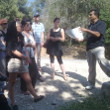Home > Oasis of Peace > Visiting > Visitors Center > A group visit to the pre-1967 village of Emmaus
A group visit to the pre-1967 village of Emmaus
Saturday 11 August 2012, by
All the versions of this article: [Deutsch] [English]

On Saturday August 11th, a group of Swiss students came to Wahat al-Salam Neve Shalom to hear about the joint Arab/Jewish village and meet its members. After meeting with Jewish community member, Bob Mark, and learning about Wahat al-Salam Neve Shalom (the basic program), the students went on a study tour to the nearby Palestinian villages that were destroyed.
The tour, which is one of the programs the visitors center offers visitors and guests coming to Wahat al-Salam Neve Shalom, was led by Umar Ighbariyyeh, a Palestinian member of the community and part of Zochrot - an organization dedicated to documenting and raising awareness about the Palestinian villages and history that were destroyed in 1948 (the Nakba) and 1967 (the Naksa).
So on a hot Saturday afternoon, the Swiss students, joined by youth and members from the village, headed out to the village of Emmaus. The tour started with a brief history and introduction to the area and the three destroyed Palestinian villages- Emmaus, Beit Nuba and Yalo, presentation of a map showing their location in the occupied West Bank in 1967, the link between the occupation in 1967 and the attempt to occupy the area in 1948 and the process of obliterating the Palestinian identity by creating a public park belonging to the Jewish National Fund.
Emmaus was a Palestinian village, destroyed after its occupation in the 1967 war (aka the Six Day War) during which Israel occupied the West Bank (called Naksa by the Palestinians). Its population was an estimated 2000 people. The village had around 5,000 dunams of land, with agriculture being the main occupation in the village. Emmaus was known for its bounteous harvest of wheat and cereals, grapes, olive trees, fig trees, almond trees and prickly pears, which the residents grew with the help of water from its famous springs. Fruit trees and stands of prickly pear still remain as testimony to the village that was (leaflet Page 1, Page 2.
After the introduction, the group headed out on foot through the remains of Emmaus. Following a path to the center of the village, they visited the main cemetery and the shrine of Sheikh Ubeid, where Umar showed the group photos of Emmaus before, during and after demolition. Then they visited the few remains that still exist of two houses and the Bayader area (a Bayader is where the farmers brought their harvested wheat for processing), where now stands a wall with names of donors to the Jewish National Fund. The color photographs that remain of the village were taken by Jewish photographer Yosef Hochmann, from nearby Kibbutz Har’el, and in them one can see the village of Emmaus in full, standing empty of its residents, the Palestinians leaving with few possessions on their back as the Israeli soldiers stand by watching and the bulldozers that erased everything.
In June 1967, the Israeli Army, forced the villagers out of Emmaus, making them walk to Ramallah, carrying with them what they could of their belongings, not knowing they would never be able to return. A few days after the evacuation, bulldozers were brought in and the village was razed to the ground. In its place, the Jewish National Fund, with the help of donations given in good faith by Canadians, started planting trees and created what is called today the Ayalon-Canada Park, a popular park where Israelis, oblivious to the history of the place, enjoy picnics and gatherings. The place contains no signs relating to its Palestinian past, though signs do relate to other historical periods. One such sign directs people to a walking trail which leads to “the Roman Bath”. The site indeed contains a building used as a bath house, but more recently this was a well-known shrine to Sheikh Ubeid, and the building is situated amongst the ruins of Emmaus’ cemetery.
Nowadays what is left of Emmaus is this cemetery, the springs and the stones of houses, reused to mark trails and create resting places for visitors to the park.
Only the keen and critical eye can spot the lone metal frames and scattered old stones strewn throughout the trees in the “Ayalon-Canada Park”, the lands of Emmaus, and read them as a silent reminder of what was and what could have been.
See also our report of the Memory and Recognition event on the subject of these destroyed villages, organized by the Pluralistic Spiritual Center in September 2003.